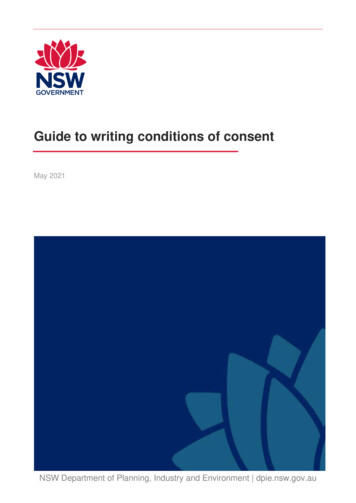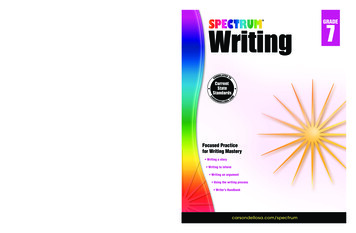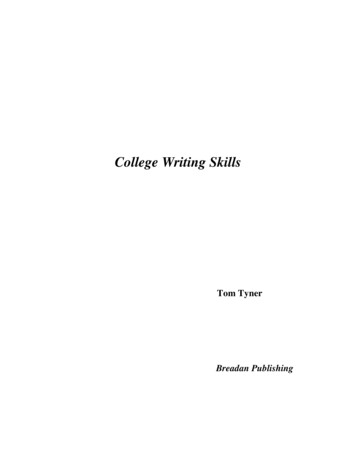
Transcription
Guide to writing conditions of consentMay 2021NSW Department of Planning, Industry and Environment dpie.nsw.gov.au
Published by NSW Department of Planning, Industry and Environmentdpie.nsw.gov.auTitle: Guide to writing conditions of consentFirst published: May 2021 State of New South Wales through Department of Planning, Industry and Environment 2021. You may copy, distribute, display,download and otherwise freely deal with this publication for any purpose, provided that you attribute the Department of Planning,Industry and Environment as the owner. However, you must obtain permission if you wish to charge others for access to the publication(other than at cost); include the publication in advertising or a product for sale; modify the publication; or republish the publication on awebsite. You may freely link to the publication on a departmental website.Disclaimer: The information contained in this publication is based on knowledge and understanding at the time of writing (May 2021)and may not be accurate, current or complete. The State of New South Wales (including the NSW Department of Planning, Industry andEnvironment), the author and the publisher take no responsibility, and will accept no liability, for the accuracy, currency, reliability orcorrectness of any information included in the document (including material provided by third parties). Readers should make their owninquiries and rely on their own advice when making decisions related to material contained in this publication.
Guide to writing conditions of consentContentsAbout this Guideline . 1Why is the Guideline necessary? . 1Quality conditions . 2Who will use the Guideline? . 2What does it cover? . 2Conditions of consent . 3Imposing conditions . 3Best practice when preparing conditions . 5Validity . 5The Newbury Test. 5Planning purpose . 5Fairly and reasonably relates to the development . 6Unreasonableness . 6Enforceability . 7Structuring the consent. 7Notice of determination . 7Advisory notes . 7Reasons for imposition of conditions . 8Writing the conditions . 9Structure of individual conditions of consent . 9Number of conditions. 9Drafting principles. 10Common conditions . 11Conditions requiring minor design changes . 11Standard conditions . 12Deferred commencement conditions . 13Conditions requiring ancillary matters . 14Conditions requiring management plans . 14Prescribed conditions. 15Modification applications . 15Staging development . 15NSW Department of Planning, Industry and Environment i
Guide to writing conditions of consentAbout this GuidelineThis Guideline aims to simplify development consents and facilitate best practice.The Guideline provides general advice around conditions of consent and notices of determination,as these are applied to local and regionally significant development under Part 4 of theEnvironmental Planning and Assessment Act 1979 (the Act).The Guideline does not provide advice in relation to conditions of consent for State significantdevelopment.Why is the Guideline necessary?The Department of Planning, Industry and Environment (Department) is introducing a suite ofreforms to deliver a better planning system for NSW as part of the Planning Reform Action Plan.Work is underway to reduce assessment time frames for all development types, improve certaintyand ensure development consents can be implemented without significant costs or delays.Ultimately, these improvements will facilitate development, keep the economy moving and supportthe state's recovery from the COVID-19 pandemic.The department is working to achieve a more consistent approach to the preparation andapplication of development consent conditions across all local government areas in NSW.This Guideline aims to: provide general assistance to consent authorities (such as councils and planning panels) inpreparing appropriate, well-structured and legally enforceable conditions and developmentconsentsidentify when to apply site-specific conditionshighlight the key issues that arise with conditions and solutions that will make conditionseasier to implement for both councils and registered certifiershelp others who interact with the planning system – from builders and developers to homerenovators or affected landowners – to understand more about conditions of consent.For many, much of what is in this Guideline may reflect what you do every day – in that case, it is areminder of best practice. For others, the Guideline will help you to understand the purpose ofconditions and provide general advice in drafting plain English conditions.Improvements to the way conditions of consent are written and applied will not only assisteconomic recovery in the short term, it will help to reduce approval timeframes, increaseconsistency and certainty, and make development consents easier to navigate and apply.The way conditions of consent are written can differ between councils – this mightmean that a builder working on two sites on opposite sides of a road, but indifferent local government areas, has to address different conditions for the samework, such as site fencing.A more consistent approach, especially for elements common across all types ofdevelopment, will help to reduce the complexity associated with complying withthose conditions.NSW Department of Planning, Industry and Environment 1
Guide to writing conditions of consentQuality conditionsConditions should be valid, easy to implement, enforceable and easy to understand. All partiesmust be clear on their obligations.Quality conditions are those that: are within the statutory power to be imposed;are drafted in plain English using specific and clear language;provide criteria that will ensure a clear and enforceable outcome;do not duplicate information;are relevant to the likely impact of the development;are logically ordered according to development stages; andhave considered the nexus (or direct relationship) between the condition of consent and thedevelopment for which consent has been granted.For conditions to be easily understood and complied with, you should write them in plain English,clearly identify the responsible individual or entity that needs to act on the condition, and identifythe timing for when the condition will take effect and when the requirements of the condition are tobe satisfied.Conditions cannot be used to redesign significant aspects of a proposed development. Generally, ifthe only way a development application (DA) can be approved is through the imposition ofconditions that require significant changes or redesign, it may be necessary to consider whether torequest further information before approving the DA or refuse the DA. Similarly, a condition shouldnot be so onerous that it is effectively a refusal of the DA.Through consultation we’ve identified poor conditions are those that: lack specific criteria;go beyond the scope of the power to impose conditions;are superfluous or too extensive –150 conditions for a dwelling house is excessive;relate to issues that should be resolved before determination of the DA;use ambiguous standards, making them difficult to implement;lack a specific timeline for when conditions must be satisfied;are not appropriate for the site or are unrelated to the development for which consent hasbeen granted; and are overly legalistic and complex.Who will use the Guideline?This Guideline is targeted to development assessment planners at councils who generally draft theconditions of development consent for local and regionally significant development under Part 4 ofthe Act. It may also be relevant to other technical staff in councils, members of planning panels andregistered certifiers. For example, council officers who are specialists in engineering, heritage,landscaping or waste may be required to draft conditions.The Guideline may also be used by other groups who interact with the planning system, such ashomeowners, builders, architects and specialist consultants.What does it cover?This Guideline begins with an introduction about conditions of consent, how they fit within the NSWplanning system and how they are used, in practice, every day.NSW Department of Planning, Industry and Environment 2
Guide to writing conditions of consentIt also addresses how to: prepare conditions of development consent and use a standard format for developmentconsents;use consistent wording and structure, including examples on how to structure the condition;prepare clear, measurable and consistent conditions in plain English that can also be usedto ensure compliance and be enforceable;provide advice on common types of conditions imposed by councils; andwork with the prescribed conditions contained in Part 6 Division 8A of the EnvironmentalPlanning and Assessment Regulation 2000 (EP&A Regulation).Conditions of consentDevelopment applications require approval from a consent authority in the form of a developmentconsent (also called a notice of determination). A DA may be determined by: granting consent unconditionallygranting consent subject to conditionsrefusing consent.Consent is rarely granted without the imposition of conditions. Consent may also be granted foronly part of the development that was the subject of the DA with subsequent applications requiredto obtain consent for the balance of the development.Stage 1: Pre-lodgementStage 2: Lodgement, notification,referral and allocationStage 3: AssessmentStage 4: DeterminationStage 5: Post-determination Pre-DA meeting / advisory services DA lodged, internal and external referrals, neighbour notification Identify issues, any non-compliances, review submissions DA approved with conditions Prepare notice of determination, approved plansFigure 1 – Development Approval Process OverviewImposing conditionsConditions of consent control and regulate the implementation and operation of approveddevelopment. Conditions are designed to: eliminate or mitigate environmental impacts – for example, the risk of a developmentleaching soil or debris across the neighbourhood or building material polluting waterways;ensure compliance with existing development controls – for example, by specifying heightlimits;ensure construction is undertaken safely in a manner that minimises any associatedenvironmental impacts for adjoining or surrounding properties;amend minor aspects of a development in a way that brings about the best possibleenvironmental and planning outcomes – for example, by raising the heights of window sillsor requiring the installation of a privacy screen on first-floor windows on the developmentsite where necessary to address unreasonable overlooking of the principal area of privateopen space available to the occupants of adjoining properties (e.g. a paved alfresco diningarea used more intensively than the remainder of the backyard);NSW Department of Planning, Industry and Environment 3
Guide to writing conditions of consent ensure the payment of relevant fees and charges such as long service levy payments ordevelopment contributions;regulate the ongoing use of a development – for example, hours of operation or ongoingnoise limits; andcomply with legal and statutory requirements.Most importantly, conditions provide certainty to both the consent holder1 and the community aboutthe consent holder’s obligations throughout the life of the development - from the time thedevelopment consent is granted to how the development is used.1Consent holder means the applicant or any other person entitled to act on a consent granted by the consent authority.NSW Department of Planning, Industry and Environment 4
Guide to writing conditions of consentBest practice when preparing conditionsThis section details the processes that represent best practice when preparing conditions ofconsent, using examples.ValidityEvery condition must be valid if it is to be legally enforceable. In this regard, every condition must: be authorised by the Act, particularly section 4.17; andsatisfy the Newbury Test.As well as section 4.17 of the Act, conditions of consent can be imposed under other parts of theAct (for example, section 4.47(3) for integrated development) or other legislation in certaincircumstances, such as section 27(1)(b) of the Coastal Management Act 2016 and section 7.13(3)of the Biodiversity Conservation Act 2016.Section 4.17 of the Act provides for the imposition of conditions of development consent in bothgeneral and specific circumstances. A condition of consent must have a lawful foundation. Thissection of the Act provides a framework on: the circumstances in which a condition of consent may be imposed where a condition may be imposed in relation to ancillary aspects of development conditions expressed in terms of outcomes or objectives conditions requiring modification or surrender of consents or existing use rights conditions and other arrangements regarding security reviewable conditions conditions that may be prescribed by the regulations.The Newbury TestThe Newbury Test is named after a 1981 court case,2 the findings of which make it clear that acondition must: be imposed for a planning purpose – not an ulterior one;fairly and reasonably relate to the development that is the subject of the developmentapplication; andnot be so unreasonable that no planning authority would have imposed it.Planning purposeThe condition must have a planning purpose; that is, it must be related to a matter eitherexpressly permitted or implied in the Act. For example, a planning purpose would includeaddressing any relevant matter for consideration that a council must take into account whendetermining a DA under section 4.15 of the Act.2Newbury District Council v Secretary of State for the Environment [1981] AC 578.NSW Department of Planning, Industry and Environment 5
Guide to writing conditions of consentExampleA 2004 case,3 found:“A planning purpose is one that implements a planning policy whose scope is ascertainedby reference to the legislation that confers planning functions on the authority, not byreference to some preconceived general notion of what constitutes planning.”In a 2003 court case,4 a condition required the applicant to negotiate with the council overthe purchase of land for open space and drainage. If no agreement was made on the price,council was to compulsorily acquire it.The court decided the condition was not for a planning purpose because the Act does notallow a council to acquire land; this power is found in the Local Government Act 1993.Fairly and reasonably relates to the developmentWhether a proposed condition fairly and reasonably relates to the development depends on eachsituation. Generally, there should be a nexus between the proposed condition and thedevelopment for which consent is granted. Nexus relates to a reasonably perceived connectionbetween the proposed condition and the environmental impact that the condition seeks to mitigate.ExampleIn a 2008 case,5 the court found that a condition imposed for a right of carriagewayat the back of a four storey mixed use development did not fairly and reasonablyrelate to the permitted development; the development would not generate theneed for it and, instead, the condition was being used to fulfil a long-standingintention of the council to address existing traffic issues.UnreasonablenessGenerally, the Land and Environment Court of NSW has found conditions that have no nexus withthe development, have no regard to the scale or scope of the proposed development, or whichconflict with public policy, are unreasonable.ExampleIn a 2005 case,6 the court found that a condition requiring the applicant to alter theterms of a drainage easement and to pay the council’s legal costs anddisbursements for checking related documentation was unreasonable. Thecondition required the applicant to accept an open-ended obligation to pay thecouncil’s legal costs.A condition of consent that does not satisfy the principles under the Newbury Test is at greater riskof a successful court challenge, where it could be declared to be invalid.3Western Australia Planning Commission v Temwood Holdings Pty Ltd [2004] HCA 63.Lean Lackenby & Haywood Liverpool Pty Ltd v Baulkham Hills Shire Council [2003] NSWLEC 406.5 Dogild Pty Ltd v Warringah Council [2008] NSWLEC 53.6 Pickwell v Ku-ring-gai Council [2005] NSWLEC 59 at [28].4NSW Department of Planning, Industry and Environment 6
Guide to writing conditions of consentEnforceabilityConditions on a development consent must be enforceable. Non-compliance with conditions ofconsent may constitute a breach of the consent, a breach of the Act, and amount to an offence andmay lead to enforcement action and penalties.All conditions of consent should be written using plain English to promote clarity and enforceability– see the section on writing conditions for further information.Structuring the consentConsistent structure, language and terminology will lead to development consents and conditionsthat are easy to understand and that are more easily satisfied.Consistency is a simple but effective way to create an easier system for applicants and certifiers,while also reducing workloads for assessments planners and limiting unlawful conditions anddelays in the development assessment process.Example – Consents involving building worksYou should generally structure a development consent involving building work inthe following way: Part A – General conditionsPart B – Before the issue of a construction certificatePart C – Before the commencement of building workPart D – While building work is being carried outPart E – Before the issue of an occupation certificatePart F – Occupation and ongoing useYou may require additional parts – for example, you may need a section onconditions that must be satisfied before demolition work or the issue of asubdivision certificate (where applicable).The structure of a consent should reflect the nature of the development and the manner in which itis to be carried out. Whilst the above structure may be suitable for development involving buildingworks, it may not be appropriate, for example, for other types of development, such as the use ofland, or development that has several stages.Notice of determinationThe notice of determination provides the consent authority’s decision in relation to the DA. Clause100 of the EP&A Regulation sets out the information that must be included in a notice ofdetermination if a DA is approved, including the conditions of consent.This includes: dates from which the consent operates and lapses;the approval bodies (as in, the relevant State agencies) that have given General Terms ofApproval (GTAs);whether the applicant and any objector has a right of appeal against the determination; anddeferred commencement (if required).Advisory notesAdvisory notes may be provided in the notice of determination but won’t form part of the consentand are not legally enforceable. Make sure advisory notes don’t contain any obligations thatrequire enforcement; only include them to provide relevant advisory information about the consent.NSW Department of Planning, Industry and Environment 7
Guide to writing conditions of consentExamples include the need to: obtain other separate approvals if required (for example, approvals under section 68 of theLocal Government Act 1993 and section 138 of the Roads Act 1993);advise certifiers and others that all conditions should be carefully read, and not to assumethey are all listed under the relevant headings of the consent; andexplain or provide information relating to a condition (for example, a condition regardingpayment of development contributions may need a note outlining methods of payment orreference to the relevant development contributions plan).Reasons for imposition of conditionsThe EP&A Regulation requires a notice of determination to contain the consent authority’s reasonsfor imposing conditions except for conditions prescribed under section 4.17(11) of the Act.The requirement to provide reasons in clause 100(1)(c) of the EP&A Regulation is supported bythe following general principles regarding the giving of reasons: reasons should be “expressed in clear language so that they are capable of beingunderstood”7;reasons should not be expressed in “vague generalities”8; andreasons should be given “so far as is necessary to indicate to the parties why the decisionwas made and to allow them to exercise such rights as may be available to them in respectof it”9.Best practice compliance with the above principles and the requirement in clause 100(1)(c) of theEP&A Regulation means that a consent authority should include a clear reason under eachcondition imposed on a notice of determination. It must not be a generic statement at the beginningor end of the notice of determination advising generally of the reasons all conditions of the consentwere imposed.Doing so will enhance transparency and accountability and assist the consent holder to complywith the relevant conditions and/or to exercise review or appeal rights under the Act. It also allowsthe consent authority to adequately explain the context and background for each condition.7Comcare Australia v Lees [1997] FCA 1415.Re Ansett Transport Industries (Operations) Pty Ltd and Another v Kenneth F Wraith and Others [1983] FCA 179.9 Housing Commission of New South Wales v Tatmar Pastoral Co Pty Ltd (1983) 3 NSWLR 378 at 386.8NSW Department of Planning, Industry and Environment 8
Guide to writing conditions of consentWriting the conditionsStructure of individual conditions of consentA consistent structure should be used within each condition that follows four simple considerations:when, who, what and how: When is the condition to be enacted or fulfilled?Who are the responsible parties in this condition?What are the specific requirements?How the requirements are to be satisfied?Example - Basement car parking detailsBefore the issue of the relevant construction certificate [WHEN], a suitably qualified civil/trafficengineer [WHO] must review the vehicle access and parking layout and provide writtencertification on the approved plans to satisfy the certifier that [HOW]:a. All parking space dimensions, driveway and aisle widths, driveway grades, transitions,circulation ramps, and other trafficked areas comply with AS 2890.1-2004 Off street parkingfacilities. [WHAT]b. A height of XXm (depends on the size of the trucks to be used) must be provided overthe designated garbage collection truck manoeuvring areas within the basement (if onsitegarbage collection is proposed). [WHAT]c. No doors or gates are located in the access driveways to the basement car park thatprevent access for internal garbage collection from the basement garbage storage andcollection area. [WHAT]This format will make the purpose of the condition and requirements to satisfy it explicit. Theintended outcome will be both clearly defined and enforceable.Where possible, link the conditions to a definitive set of criteria/objectives. This could include arequirement for a condition to comply with an Australian Standard or specifications set out in adevelopment control plan (DCP) (either “as modified” or at a particular point in time).Number of conditionsConsent authorities should aim as far as possible to minimise the number of conditions imposed ona development consent – doing so will make it easier for the consent holder to understand what isrequired by the consent. While limiting the number of conditions imposed on a consent is not anobjective of condition writing, the development consent should deal with all relevant issues assuccinctly as possible.Before imposing a condition of consent, consider whether the condition: is necessary to achieve the best outcome for the development;is covered by another condition of consent; andcould be combined with another condition of consent.The number of conditions is likely to vary depending on the scale or complexity of the development(for example, the number of conditions for a single dwelling house is likely to be fewer than for aresidential flat building).NSW Department of Planning, Industry and Environment 9
Guide to writing conditions of consentDrafting principlesOther important principles in drafting conditions include:Use plain English wherever possible. This means avoiding terms like “pursuant to” or “prior to”and just saying “under” or “before”.Make the conditions clear, so they can be easily interpreted by those they impose obligations on,including a council or a registered certifier, depending on who is appointed to certify the approveddevelopment. Avoiding ambiguity will also enable the person acting on the condition to understandwhat is required of them. Remember that if a poorly drafted condition is ambiguous or arequirement is not stated, a court will likely interpret it favourably for the consent holder and thismay cause an unintended outcome.Be aware that expressions like “generally in accordance with” will allow some variance incompliance – avoid them as much as possible, particularly if strict compliance with a requirement isnecessary.Example - Hours of operationIn an instance where a council had failed to outline the approved hours ofoperation for a commercial laundry, the court10 found the premises wereeffectively afforded 24/7 operational hours.Use definitive wording such as “must” or “will”. Avoid words such as “should” or “may” whichcreate a discretion and could render the condition unenforceable.Be concise as conditions covering multiple requirements or issues can become complex. Thismakes it harder for a consent holder to be satisfied as to what the condition requires forcompliance and hinders future enforcement of potential non-compliances.Write the condition in a way that helps the consent holder to comply with the condition asthis will result in a better outcome for the consent holder and those affected by the development. Aclear condition will also make it easier to assess compliance (or non-compliance) – especially forongoing conditions that will apply for the life of the development (these create an ongoingobligation for consent holders who may not be the original applicant and an ongoing compliancerole for council).Example - Maintenance of wastewater and stormwater treatment deviceDuring occupation and use, the consent holder must ensure all wastewater andstormwater treatment devices (including drainage systems, sumps and traps, andonsite detention) are regularly maintained to remain effective and in accordancewith any relevant positive covenant created under this consent. All solid andliquid waste collected from the wastewater and stormwater treatment devicesmust be dis
Section 4.17 of the Act provides for the imposition of conditions of development consent in both general and specific circumstances. A condition of consent must have a lawful foundation. This section of the Act provides a framework on: the circumstances in which a condition of consent may be imposed











